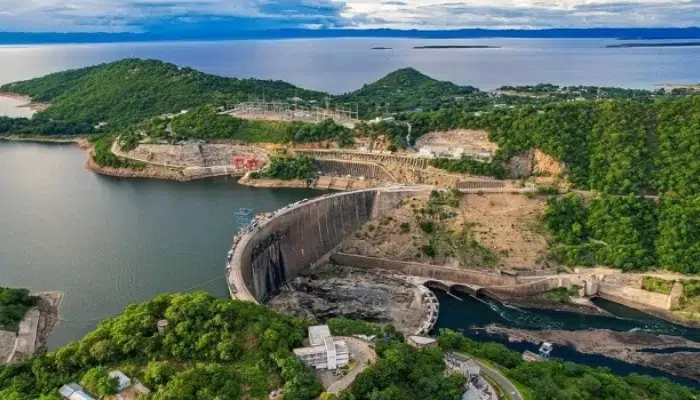Resources
A Nation in Darkness: The Untold Story of Zambia’s Power Crisis

- Zambia is experiencing a significant power outage due to drought and an overreliance on electricity from the Kariba and Kafue Gorge Dams.
- Frequent power outages are impacting industry, residences, and critical services such as healthcare and education.
- The situation is exacerbated by deforestation, sedimentation, and dams’ environmental impact on aquatic habitats.
- Zambia’s 84% reliance on hydroelectricity has prompted a movement to diversify energy sources, including coal and solar power.
- The government’s response to the situation includes investments in renewable energy, solar technology, and a new coal-fired power plant.
Zambia, a landlocked country in southern Africa, is currently experiencing a catastrophic power outage that has impacted both the economy and society. The dilemma, caused by a variety of circumstances, is fundamentally linked to the country’s reliance on hydropower, which is principally supplied by two big dams: the Kafue Gorge Dam and the Kariba Dam. Both of these mammoth constructions were once viewed as emblems of national success, but they are now at the root of Zambia’s deteriorating energy situation. This article investigates the causes of the problem, its far-reaching implications, and potential solutions to assist Zambia attain a more stable energy future.
Kafue Gorge Dam: From Hope to Miscalculation
Built-in the 1970s, the Kafue Gorge Dam was intended to be a crucial component of Zambia’s energy strategy, delivering hydroelectric power to fulfil the country’s expanding demand. However, over time, the dam has encountered considerable obstacles, mainly sedimentation, reducing its efficiency. Sediment building in Lake Kariba, the dam’s reservoir, has reduced the dam’s ability to generate energy. Deforestation and unsustainable farming in the dam’s catchment area contribute to the accumulation of silt and debris.
Furthermore, the dam’s construction has caused significant environmental damage, altering the natural flow of the Kafue River and threatening aquatic ecosystems. Communities that rely on the river for agriculture, fishing, and daily water supply have suffered, with some being forced from their homes. What had represented Zambia’s energy future is now contributing to its current crisis.
The Power Crisis: A Country in Darkness
Zambia’s electricity shortages have had a catastrophic impact on almost every area of the economy. Industries that rely significantly on regular power, such as mining and manufacturing, have had to reduce operations, relocate, or shut down completely. This has resulted in considerable employment losses, decreased exports, and a notable drop in government revenue.
The crisis has also had a significant impact on agriculture, which is an important element of Zambia’s economy. Farmers who rely on electricity-powered irrigation systems have been unable to irrigate their crops, resulting in diminished harvests and increased food insecurity. These power outages disproportionately affect small-scale farmers, who are already exposed to economic shocks and climate change.
On a societal level, the crisis has caused widespread dissatisfaction. Basic services have been severely impacted as cities and villages have been without power for days at a time. Hospitals struggle to function without reliable energy, putting further strain on an already weak healthcare system. Schools, too, have been impacted, with students unable to study or access resources owing to continuous power outages.
Furthermore, the crisis has led to economic inequality. Urban areas with access to generators have found reprieve, while most rural settlements are still without power. The cost of generator fuel has also risen, putting an additional strain on people who are already trying to get by.
The Kariba Dam: Nature’s Impact
The Kariba Dam, built on the Zambezi River, has been another pillar of Zambia’s energy infrastructure. Drought and El Niño weather patterns have had a significant impact in recent years. The lack of rainfall has significantly reduced water levels, and only one of Zambia’s Kariba North Bank Power Station’s six turbines is currently working. This has limited the station’s output to only 7% of its maximum capacity, exacerbating the country’s energy crisis.
Zambia gets 84% of its electricity from hydropower, therefore reliance on reservoirs like Kariba has proven to be a major weakness. The government has had to import electricity from neighbouring nations such as Mozambique and South Africa, but this is not a long-term solution.
Potential Solutions: Creating a Sustainable Future
Addressing Zambia’s power issue necessitates both short-term assistance and long-term sustainable solutions. In the short term, diversifying the country’s energy sources is vital. Zambia’s excessive reliance on hydropower has proven problematic, particularly in the face of climate change and unpredictable rainfall patterns. Despite environmental concerns, expanding solar energy, wind power, and even coal plants could assist in stabilising the energy supply.
The Zambian government has previously taken steps to encourage solar energy, including eliminating import fees on solar equipment and encouraging businesses and households to employ solar solutions. However, solar panels remain too expensive for many Zambians, necessitating additional government subsidies or novel financing strategies to expand solar adoption.
In the long term, Zambia must engage in reforestation and sustainable land management measures to reduce sedimentation in its dams. Addressing environmental degradation in the catchment areas of significant reservoirs such as Lake Kariba is critical to the long-term viability of hydropower. Furthermore, improving governance and establishing accountability measures in the energy industry can help to avoid future catastrophes.
Furthermore, regional cooperation may provide a route ahead. Zambia could consider cross-border energy agreements with neighbours such as Zimbabwe and the Democratic Republic of the Congo to ensure a more consistent electricity supply and to develop collaborative energy infrastructure projects.
Conclusion
Zambia’s power crisis is a stark reminder of the dangers of over-reliance on a single energy source. The Kafue Gorge and Kariba dams, once emblems of progress, have now contributed to the country’s chronic energy challenges. While short-term measures such as importing power and investing in alternative energy will provide some relief, long-term sustainability will necessitate tackling the underlying causes of the crisis—environmental deterioration, inadequate governance, and limited energy diversification. By addressing these concerns front on, Zambia can create a more robust energy infrastructure and provide a brighter future for its population.
This dilemma serves as a sharp warning that energy planning must evolve to meet changing environmental conditions and the demands of a growing population. Zambia has the potential to overcome this crisis and move towards sustainable development if the government, civic society, and the private sector work together.

















































